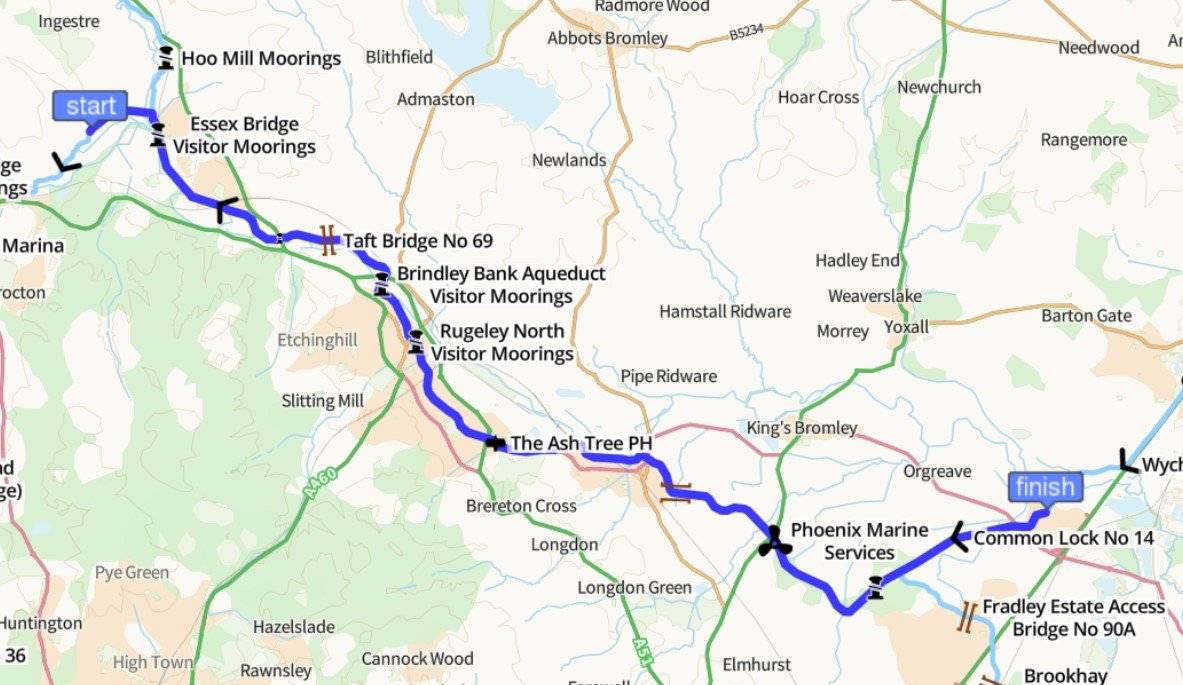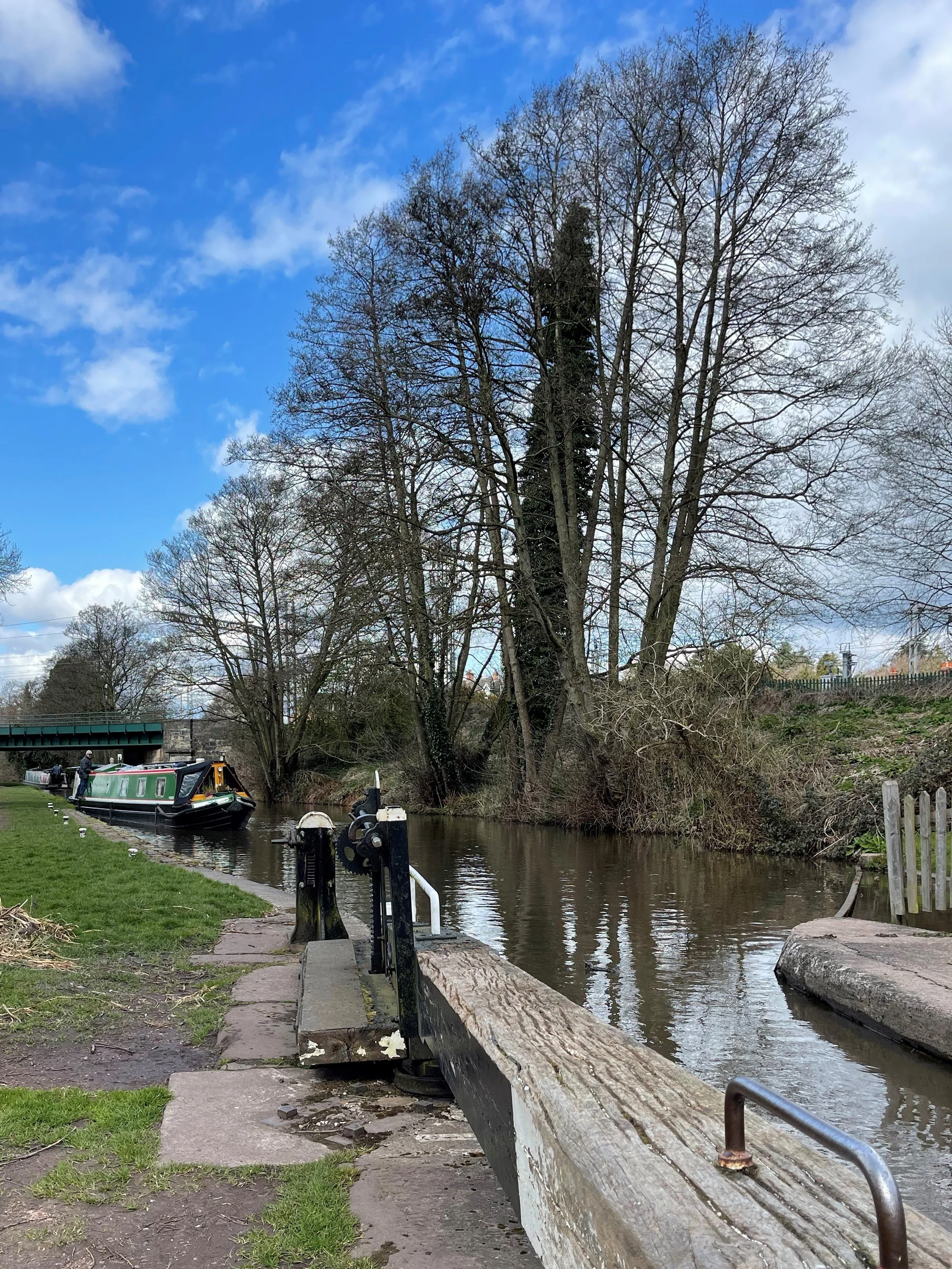Tixall Wide to Alrewas
Saturday 2nd April
Today’s journey is a distance of 15.2 Miles, with 10 Locks and will take us about 8 hours.
We are on a mission today as the weather looks good and we need to catch NB Sefton. An eight hour cruise is untypical for us as we recently as we have been doing 2 to 3 hours, with the intentions of exploring our new surroundings.
As we approach our second lock of the day the target destination of Alrewas looks a little less certain as we encounter a “Day-Trip Boat” who have never done locks before and are very focused on celebrating someone’s birthday.
We are however soon on our way after explaining the sequence of operating the lock gate paddles, reminding us of 23 years ago when we started 😊.
Leaving Colwich Lock on the Trent & Mersey Canal
A little History and you’ve guessed it 😊 it does involve a pub 😋
The Trent and Mersey Canal was built to link the River Trent at Derwent Mouth in Derbyshire to the River Mersey, it is considered of outstanding industrial archaeological importance as it was the first of the major inland waterways to form the main arteries of Britain. At a cost of approximately £300,000 to construct, its effect was dramatic, reducing transportation costs of goods by three quarters.
Map of the Trent & Mersey Canal courtesy of Wikipedia
In 1766 James Brindley’s plan was approved, known as "The Grand Trunk", the first sod was cut by Josiah Wedgwood in July that year at Brownhills, Burslem. In 1777, the canal was completed, 93 miles long, including more than 70 locks and five tunnels.
But what about the pub, I hear you say,,,, well this brings us nicely to the committee meeting place. “The Wolseley Arms”
The Wolseley Arms Public House
The inn was formerly known as The Roebuck up until 1960 when it became the Wolseley Arms. Originally, the inn was used as a regular changing place for coaches on long journeys before railways were introduced, and at one time over a hundred horses were kept at the Wolseley Arms for this purpose. In December of 1765 a meeting was held here by the company proprietors, including The Duke of Bridgwater, Earl Gower of Trentham, Thomas Anson of Shugborough & Josiah Wedgewood.
Plaque on the wall of the Worsley Arms Public House
Wonder what the local beer was called… maybe “Brindley’s Theodolite” 😊.
We continued to make good progress in the sunshine and soon came to Armitage Tunnel Footbridge, which is a short sandstone cutting, and all that remains of Armitage Tunnel. The 130-metre tunnel was the earliest example and the only one to incorporate a towpath. The roof of the tunnel was removed in 1971 due to mining subsidence caused by nearby coal mining and was replaced by the present road bridge. The stretch is only wide enough only for a single narrowboat to pass and as you can see the towpath still remains. Every time we go through this, Paul has a little challenge to himself, to cruise the entire length without touching the sides…. On this occasion he passed with honours 😊
Approaching Armitage Tunnel on the Trent & Mersey Canal
Going under the Armitage Tunnel on the Trent & Mersey Canal
Confidence is peculiar thing, too much and one can find themselves in trouble very quickly, or an innocent insouciant remark can leave one questioning everything.
Hang Loose cruising on the Trent & Mersey Canal
As we cruise the network, passers-by often comment on Paul’s lack of commitment to teamwork as Steph does all the hard work at the lock while Paul appears to aimlessly waft his arm from side to side, tiller in hand.
Today Steph was up for role reversal and took on 8 locks
With the apparent skill of a master skipper that most boaters would dream of, she never touched the side of the boat on either the lock approach or while exiting. 😌On the other hand we both concluded Paul needed a little more training. 😥
Junction Lock No 17 at Fradley
In Steph’s capable hands we soon safely arrived at our destination for the night. We do love Alrewas and we had to pop into William IV for a pint and then to the Alrewas Fryer for a chippy supper after the 8 hour cruise today!
Alrewas Visitor Moorings















